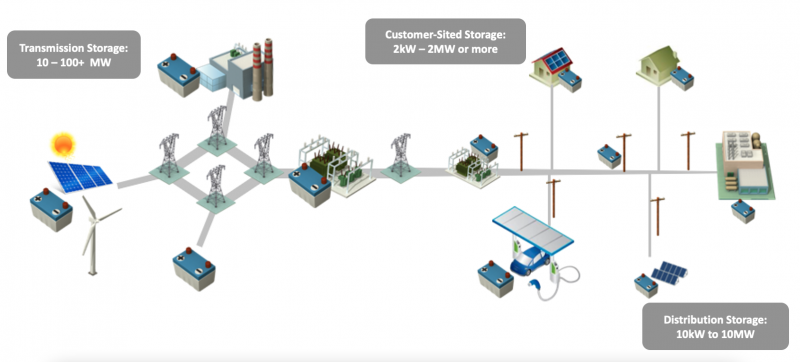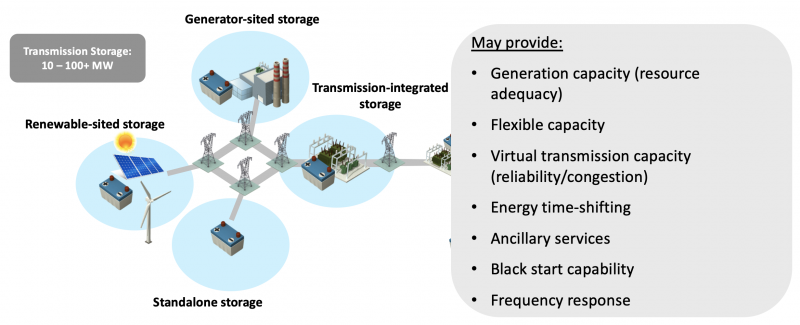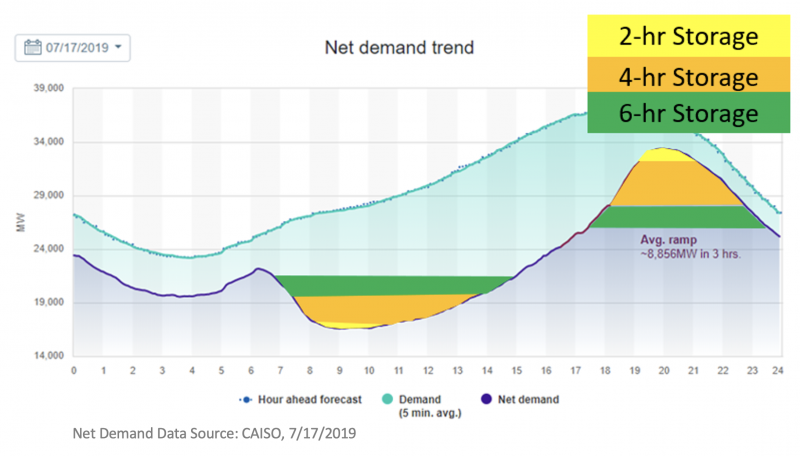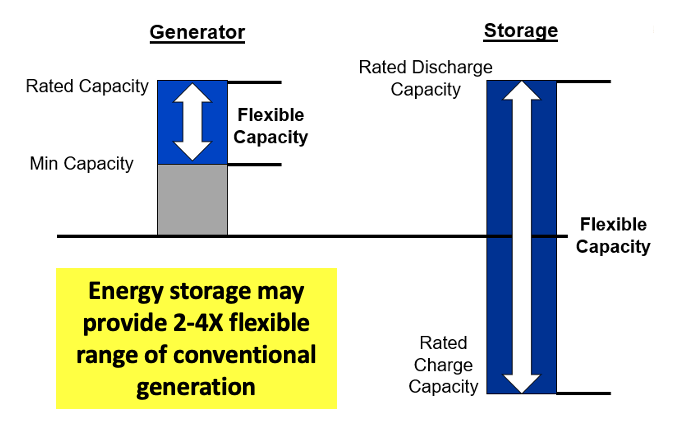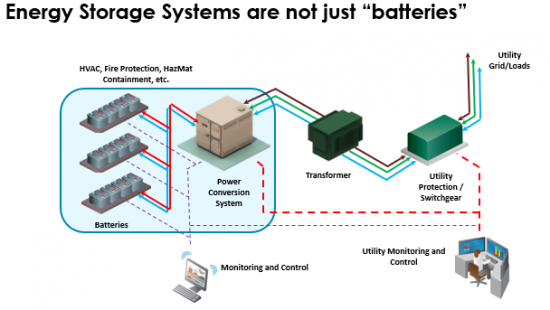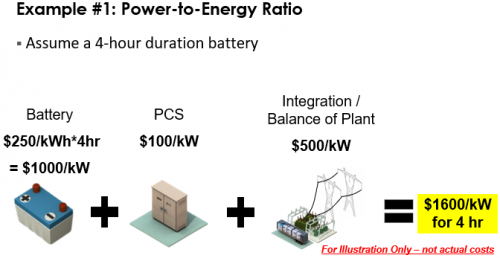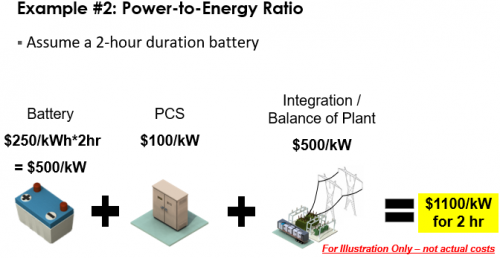Difference between revisions of "Energy Storage 101/Economics"
| Line 15: | Line 15: | ||
==Transmission-Connected and Bulk Energy Storage== | ==Transmission-Connected and Bulk Energy Storage== | ||
The figure below provides a list of the services that energy storage can provide at the transmission or bulk energy storage level (generally 10MW or more). These include generation capacity (sometimes called resource adequacy), flexible capacity (sometimes called flexible resource adequacy), virtual transmission capacity (support transmission reliability or alleviate congestion), energy time shift, ancillary services, black start, and frequency response. The section | The figure below provides a list of the services that energy storage can provide at the transmission or bulk energy storage level (generally 10MW or more). These include generation capacity (sometimes called resource adequacy), flexible capacity (sometimes called flexible resource adequacy), virtual transmission capacity (support transmission reliability or alleviate congestion), energy time shift, ancillary services, black start, and frequency response. The section provides more detail for each. | ||
[[File:Transmission Sited Storage Applications.png|none|thumb|800px|In some scenarios, bulk storage may serve as an alternative to generators or transmission assets.]] | [[File:Transmission Sited Storage Applications.png|none|thumb|800px|In some scenarios, bulk storage may serve as an alternative to generators or transmission assets.]] | ||
===Generation Capacity (Resource Adequacy)=== | ===Generation Capacity (Resource Adequacy)=== | ||
Generation capacity is the capability and availability of a resource to contribute to system load needs. Capacity resources are typically committed months to years in advance. As demand and resource mixes change, including generator retirements, new resources are needed to ensure capacity needs are met during all hours and conditions. Assuming sufficient storage duration and reliable response | Generation capacity is the capability and availability of a resource to contribute to system load needs. Capacity resources are typically committed months to years in advance. As demand and resource mixes change, including generator retirements, new resources are needed to ensure capacity needs are met during all hours and conditions. Assuming sufficient storage duration and reliable response times, energy storage may provide reliable load peak reduction. However, energy storage is more challenging to model and assess than traditional generation, because of its limited energy capacity. | ||
[[File:Energy storage scenarios CAISO demand.png|none|thumb|800px|This figure shows one day of CAISO demand data with three different energy storage duration scenarios to show how storage as a capacity resource can produce more favorable system demand profiles.]] | [[File:Energy storage scenarios CAISO demand.png|none|thumb|800px|This figure shows one day of CAISO demand data with three different energy storage duration scenarios to show how storage as a capacity resource can produce more favorable system demand profiles.]] | ||
===Flexible capacity=== | ===Flexible capacity=== | ||
As more renewables are deployed, daily fluctuations (i.e. ramp rate requirements) in traditional energy generation are increasing. Grid planners must consider these ramp rates in long-term generation resource planning. Energy storage can alleviate ramp rate requirements by absorbing or releasing energy to effectively reduce the maximum ramp rate required by generators. | |||
[[File:Flexible Capacity Transmission.png|none|thumb|800px|Because energy storage can generally charge or discharge at its rated power, it provides more flexibility than a traditional generation asset which can only produce energy in a limited range.]] | [[File:Flexible Capacity Transmission.png|none|thumb|800px|Because energy storage can generally charge or discharge at its rated power, it provides more flexibility than a traditional generation asset which can only produce energy in a limited range.]] | ||
Revision as of 11:52, 24 November 2021
Introduction to Grid Services
The economics of energy storage is reliant on the services and markets that exist on the electrical grid which energy storage can participate in. These value streams differ by region, electrical system, and grid domain (i.e. transmission, distribution, customer-sited).
Regardless of the situation, at a high level, energy storage can be utilized across the grid in the following ways:
- Capacity Resource: On the electric grid, capacity is synonymous with power, and to be a capacity resource is to provide power that is reliable and firm, so that it can be dispatched when needed. For example, energy storage can charge itself during times when there's excess capacity and essentially become a capacity resource for times when load is peaking in a particular location or region.
- Flexibility Resource: Energy storage has the ability to increase (charge), or decrease (discharge), the total load on the grid at different times very quickly. This characteristic can be leveraged to decrease ramp rate requirements and stresses on traditional assets during times when high generation ramp rates are required. For example, in the early afternoon when grid load demand is low and renewable generation is peaking, traditional generators must quickly ramp down to prevent over-generation on the system. During this time, energy storage can charge itself with excess renewable energy and discharge the energy later in the afternoon, as renewables ramp down and load demand increases.
- Backup Resource: Energy storage can act as a reservoir for energy which can be saved and used when it is needed. If electric power service is disrupted and energy storage is connected to a critical load, the load can use the energy reserve to ride out the disruption.
- Power Quality Resource: Energy storage can be used to affect the voltage or the VARs at a particular point on the grid. This can be accomplished by energy storage systems that have inverters that are capable of "4 quadrant" operation. This functionality enables the inverter and storage system to either produce or absorb VARs which can affect the voltage voltage around the point of interconnection.
Transmission-Connected and Bulk Energy Storage
The figure below provides a list of the services that energy storage can provide at the transmission or bulk energy storage level (generally 10MW or more). These include generation capacity (sometimes called resource adequacy), flexible capacity (sometimes called flexible resource adequacy), virtual transmission capacity (support transmission reliability or alleviate congestion), energy time shift, ancillary services, black start, and frequency response. The section provides more detail for each.
Generation Capacity (Resource Adequacy)
Generation capacity is the capability and availability of a resource to contribute to system load needs. Capacity resources are typically committed months to years in advance. As demand and resource mixes change, including generator retirements, new resources are needed to ensure capacity needs are met during all hours and conditions. Assuming sufficient storage duration and reliable response times, energy storage may provide reliable load peak reduction. However, energy storage is more challenging to model and assess than traditional generation, because of its limited energy capacity.
Flexible capacity
As more renewables are deployed, daily fluctuations (i.e. ramp rate requirements) in traditional energy generation are increasing. Grid planners must consider these ramp rates in long-term generation resource planning. Energy storage can alleviate ramp rate requirements by absorbing or releasing energy to effectively reduce the maximum ramp rate required by generators.
Virtual transmission capacity (reliability/congestion)
Energy time-shifting
Ancillary services
Black start capability
Frequency response
Distribution-Connected Energy Storage
Customer-Sited Energy Storage
Cost Components and Trends
Clarity on costs is a critical step in energy storage economics. Economic analysis of energy storage systems need to clearly articulate what major components are included in the scope of cost. The schematic below shows the major components of an energy storage system. System components consist of batteries, power conversion system, transformer, switchgear, and monitoring and control. A proper economic analysis identifies the cost associated with each of these components or provides reasoning for exclusion.
In addition to identification of major components, there are key BESS services that occur throughout the system's lifetime that need to be accounted for in an economic analysis. The left side of the graphic below shows the beginning of life stacked costs for battery energy storage systems. As shown in the upfront owners' costs, the largest upfront cost is the battery itself. One important consideration given the significant battery cost are the sizing assumptions that are used for cost estimates. Of the procured energy, a fraction of that energy is delivered to the customer and some fraction is reserved for safety and performance margins, degradation overbuild, AC/DC losses, or is electrochemically inaccessible. Additionally, the graphic shows costs of services throughout BESS operation. These services include operating expenses, fixed system maintenance, and decommissioning and end of life services.
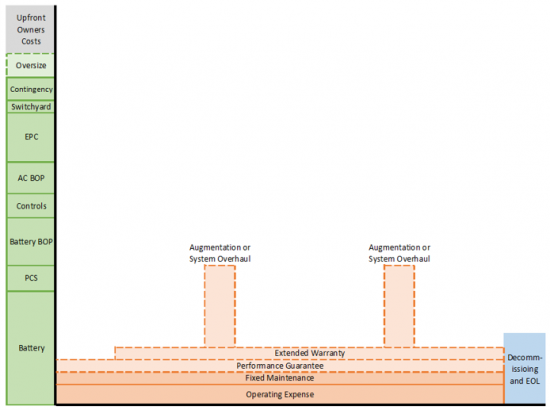
Other generation resource costs are often communicated on a $/kW basis, but energy storage has both power and energy components and the normalized cost will vary with duration. This is highlighted in two examples below where it's clear that the longer duration system has a higher cost per kW of power.
The image below shows lithium ion cost projections from a 2020 EPRI cost study. As demonstrated in the two examples above, the longer duration systems, as of 2020, are more expensive per kW than the shorter duration systems. However, EPRI's cost study projects that the cost per kW of 8 hour duration lithium ion systems is decreasing at a faster rate than 2 hour lithium ion systems.
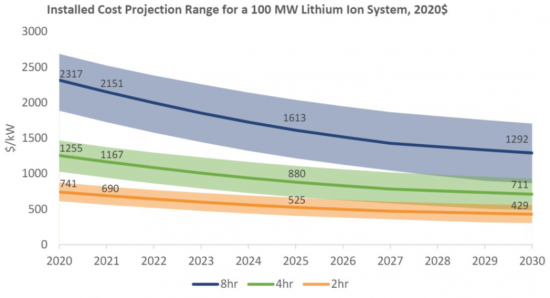
Grid Services and Uses
Energy storage has many capabilities:
- Capacity Resource: Firm power
- Flexibility Resource: Fast response and ramping
- Backup Resource: Energy reserve
- Power Quality Resource: 4-quadrant watts and VARs
The table below list the grid services energy storage can support.
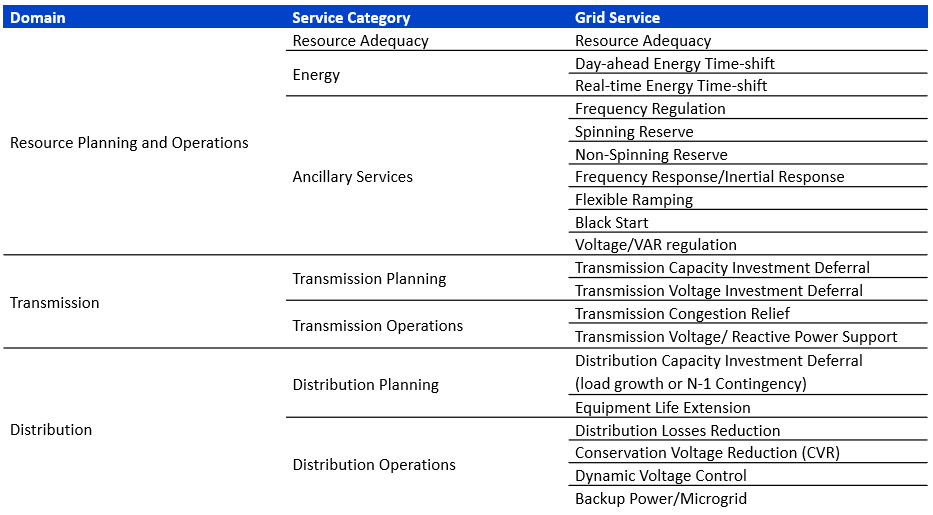
Transmission-connected storage may provide:
- Generation capacity (resource adequacy)
- Black start
- Virtual transmission capacity
- Energy time-shifting
- Ancillary services
Distribution-connected storage may provide:
- Virtual distribution capacity
- Enhance power quality
- Resiliency / backup power / microgrid
- Upstream transmission impacts – either costs or benefits
Customer-connected storage may provide:
- Customer bill savings: Retail time-of-use tariff energy shifting, Demand charge management
- Backup power
- Upstream T&D impacts – either costs or benefits
Modeling Energy Storage
Challenges to modeling energy storage include:
- Storage is not yet a common grid asset
- Rules and regulations are still evolving
- Benefit stacking is appealing, but is it possible?
- More services = more value
- More services = more requirements
- Can these requirements be satisfied?
- Storage value analyses are site-specific
- Complex co-optimization between storage technologies, objectives, and constraints
Understanding Service Compatibility
- Energy Storage Services Hierarchy
- Energy storage services only flow from bottom up, customer storage may provide distribution and transmission-level services, but transmission storage can NOT provide distribution or customer services
- Reliability vs. Economic
- Reliability takes priority (e.g. T&D deferral higher priority than market services)
- Long-term planning constraints take priority to economic optimization and constraints roll-up; Multi-year >> Annual >> Monthly >> Day-ahead >> Real-time
- Local vs. System Level
- Local objectives generally supersede system objectives when there is a conflict (e.g. T&D deferral higher priority than resource adequacy) although should be designed so that reliability services never conflict
Resources
EPRI Tools to Support Valuation Modeling
StorageVET
DER-VET
Reports
| Resource | Access Level |
|---|---|
| EPRI Solar Plus Storage Cost Assessment and Design Considerations: Executive Summary (2019) | Publicly Available |
| EPRI Energy Storage Technology and Cost Assessment: Executive Summary (2018) | Publicly Available |
| ESIC Energy Storage Cost Tool and Template | Publicly Available |
| Energy Storage Valuation in California: Policy Planning and Market Information Relevant to the StorageVET Model | Publicly Available |
